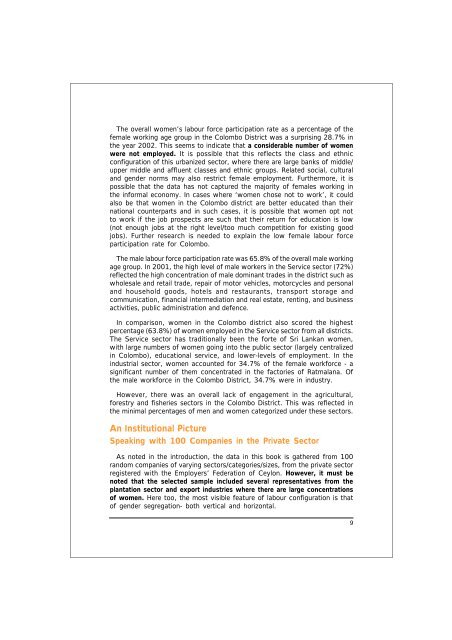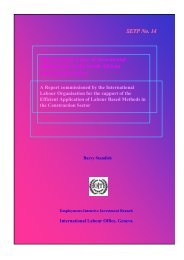Beyond Glass Ceilings and Brick Walls - International Labour ...
Beyond Glass Ceilings and Brick Walls - International Labour ...
Beyond Glass Ceilings and Brick Walls - International Labour ...
Create successful ePaper yourself
Turn your PDF publications into a flip-book with our unique Google optimized e-Paper software.
The overall women’s labour force participation rate as a percentage of the<br />
female working age group in the Colombo District was a surprising 28.7% in<br />
the year 2002. This seems to indicate that a considerable number of women<br />
were not employed. It is possible that this reflects the class <strong>and</strong> ethnic<br />
configuration of this urbanized sector, where there are large banks of middle/<br />
upper middle <strong>and</strong> affluent classes <strong>and</strong> ethnic groups. Related social, cultural<br />
<strong>and</strong> gender norms may also restrict female employment. Furthermore, it is<br />
possible that the data has not captured the majority of females working in<br />
the informal economy. In cases where ‘women chose not to work’, it could<br />
also be that women in the Colombo district are better educated than their<br />
national counterparts <strong>and</strong> in such cases, it is possible that women opt not<br />
to work if the job prospects are such that their return for education is low<br />
(not enough jobs at the right level/too much competition for existing good<br />
jobs). Further research is needed to explain the low female labour force<br />
participation rate for Colombo.<br />
The male labour force participation rate was 65.8% of the overall male working<br />
age group. In 2001, the high level of male workers in the Service sector (72%)<br />
reflected the high concentration of male dominant trades in the district such as<br />
wholesale <strong>and</strong> retail trade, repair of motor vehicles, motorcycles <strong>and</strong> personal<br />
<strong>and</strong> household goods, hotels <strong>and</strong> restaurants, transport storage <strong>and</strong><br />
communication, financial intermediation <strong>and</strong> real estate, renting, <strong>and</strong> business<br />
activities, public administration <strong>and</strong> defence.<br />
In comparison, women in the Colombo district also scored the highest<br />
percentage (63.8%) of women employed in the Service sector from all districts.<br />
The Service sector has traditionally been the forte of Sri Lankan women,<br />
with large numbers of women going into the public sector (largely centralized<br />
in Colombo), educational service, <strong>and</strong> lower-levels of employment. In the<br />
industrial sector, women accounted for 34.7% of the female workforce - a<br />
significant number of them concentrated in the factories of Ratmalana. Of<br />
the male workforce in the Colombo District, 34.7% were in industry.<br />
However, there was an overall lack of engagement in the agricultural,<br />
forestry <strong>and</strong> fisheries sectors in the Colombo District. This was reflected in<br />
the minimal percentages of men <strong>and</strong> women categorized under these sectors.<br />
An Institutional Picture<br />
Speaking with 100 Companies in the Private Sector<br />
As noted in the introduction, the data in this book is gathered from 100<br />
r<strong>and</strong>om companies of varying sectors/categories/sizes, from the private sector<br />
registered with the Employers’ Federation of Ceylon. However, it must be<br />
noted that the selected sample included several representatives from the<br />
plantation sector <strong>and</strong> export industries where there are large concentrations<br />
of women. Here too, the most visible feature of labour configuration is that<br />
of gender segregation- both vertical <strong>and</strong> horizontal.<br />
9
















